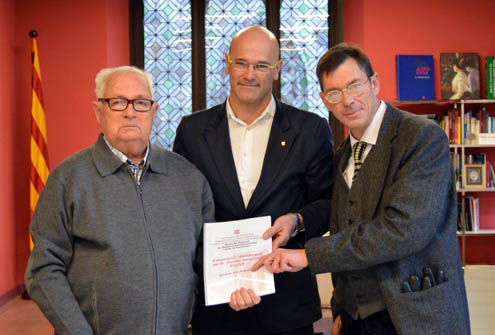- The Minister for Foreign Affairs, Institutional Relations and Transparency, Raül Romeva, has met with members of the family of Vicente Santolaria to present them with the archaeological summary and the genetic identification report
- Santolaria, who died in Tremp during Franco's dictatorship, had been accused of being a maqui, a member of the anti-Franco guerillas who continued to oppose the regime following the Spanish Civil War
- This is the seventh person, exhumed from a mass grave in Catalonia, to be identified; the first since 2008

This Wednesday morning, the Minister for Foreign Affairs, Institutional Relations and Transparency, Raül Romeva, met with members of the family of Vicente Santolaria Escrich, who disappeared during Franco's dictatorship and whose remains have been exhumed from the cemetery in Tremp. The results of the genetic identification tests on the remains have been compared with the DNA of his nephew confirming, in this way, his identity. The deceased's brother, Francisco Santolaria, and his nephew, Joan Santolaria, attended the meeting to collect the corresponding documentation and to formalise the transfer of the remains.
Romeva highlighted that with this indentification "today we begin a new period in the recovery of the memory and dignity of citizens" and remarked that "it will be a journey long and laborious, but we are determined to do justice and to settle this historical debt”. He also said that the actions that the Government promotes on historical memory “strongly contribute to the consolidation of our country and a society of peace, where there is no forgetting”. Meanwhile, Joan Santolaria explained that his father asked him before he died that he wanted to find his brother, Vicente Santolaria. Family members appreciated the work done by the Government and pointed out that "it has been a struggle that has lasted many years, but finally justice has been done."
The deceased's family made a request for the location of his remains to the Government of Catalonia. The Ministry of Foreign Affairs, through the Directorate-General for Institutional and Parliamentary Relations, and in partnership with Tremp Town Council, attended to the request for the location and exhumation of the remains of the deceased and undertook extensive research into the case in order to be able to pinpoint the exact location of his burial. Between 3 and 5 October the archaeological work was carried out that uncovered the skeleton of the deceased, buried face down, without a coffin.
Finally, the results of the genetic identification tests have confirmed that the remains are those of the person for whom they were searching. Even though the deceased died without leaving any children, the tests have been carried out by comparative analysis and cross referencing of genetic data from the remains with that of his nephew. This is the seventh person, exhumed from a mass grave in Catalonia, to be identified; the first since 2008.
The identification of those who disappeared during the Spanish Civil War and Franco's dictatorship is one of the Government of Catalonia's priority policies, and for this reason, it has promoted the Genetic Identification Programme and is working on the development of a mass graves plan in order that this case from Tremp should not be merely an exception. At the beginning of November, the Ministry began carrying out genetic testing of family members of those who disappeared in order to build a database, which will permit the cross referencing of genetic data from remains of those who died with those family members on the database.
Accused of being an anti-regime guerilla
According to the documentation compiled, Santolaria was arrested on the charge of being a maqui, a member of the anti-regime guerillas, and he died at the police station in Tremp in December 1948. He was born in 1902 in Cirat (Castelló) and moved to Barcelona as a youth, where he joined the trade union CNT. He lived in exile in France during the dictatorship of Primo de Rivera and returned on the declaration of the Second Spanish Republic. In 1931 he founded a branch of CNT in Cirat, and in 1936 he was elected mayor as candidate for the Frente Popular. A year later he joined the republican army, and in 1939 he was sentenced to six years in prison, serving his sentence in Castelló.
Santolaria had been accused of being a maqui, a member of the anti-Franco guerillas, and so, following the assault on a neighbouring village at the beginning of 1948, he left his village to take refuge, first in Barcelona, and later in a farmhouse in Mas-solana (Pallars Jussà), under a false identity. On 11 September 1948, the Guardia Civil arrested him and on 12 December of the same year he died, according to the regime's official version, as a result of suicide in a cell in the municipal jail, a claim which the forensic analysis has been unable to corroborate.
Now, almost seventy years after his death, the remains of Santolaria will be transferred to Cirat (Castelló), where they will be buried this Saturday, 14 January.
